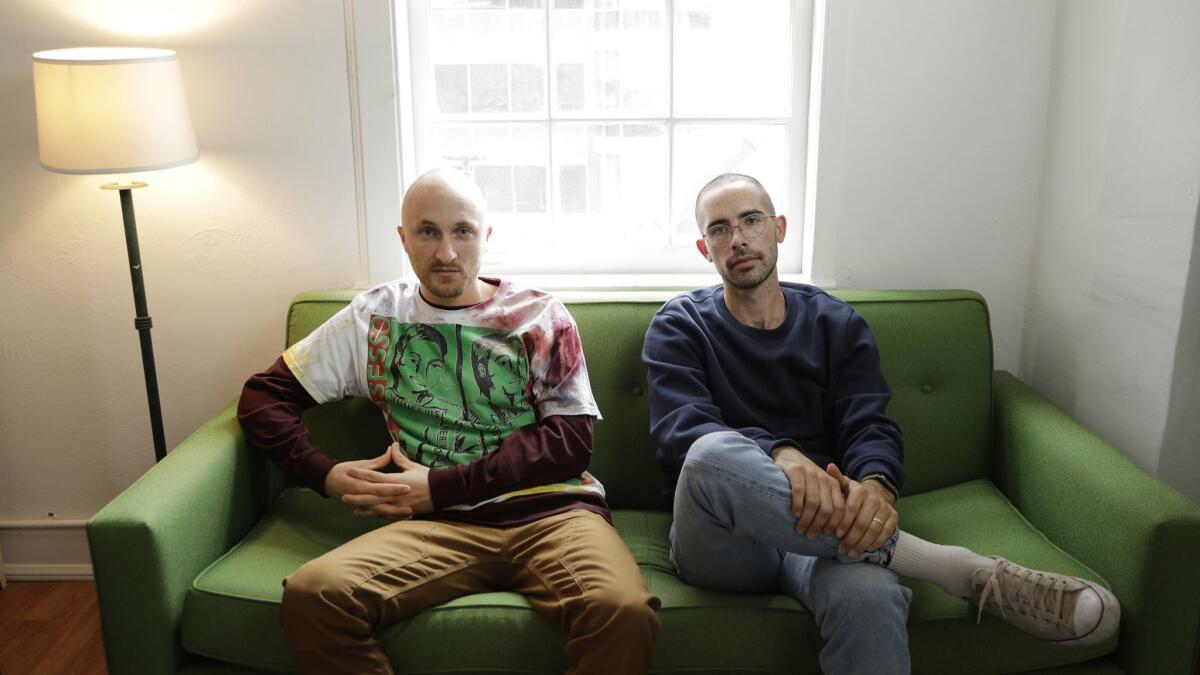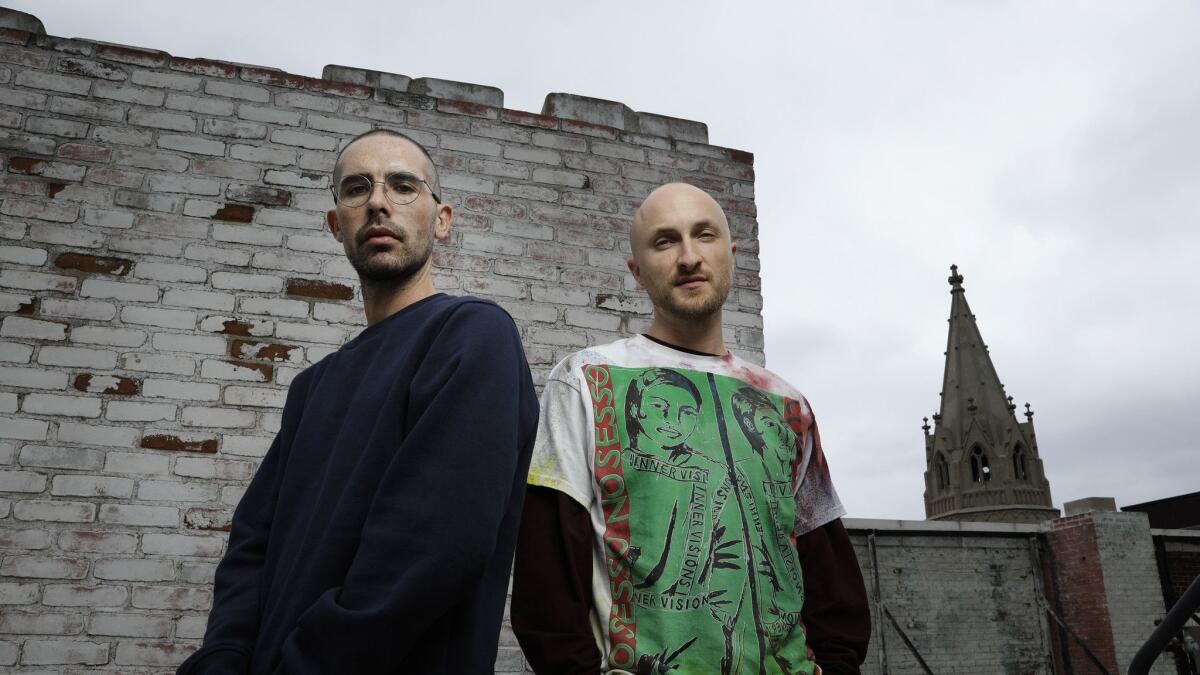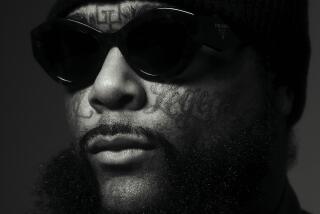L.A. production team DJDS tackles storytelling on ‘Big Wave More Fire’

Last year the two electronic beat producers known as DJDS were forced to abandon the Westlake/MacArthur Park building where they created most of their two infectious dance albums and were in the process of creating a third, “Big Wave More Fire.”
Scorched by a fire in the neighboring lot, the facility itself survived untouched. The building, though, was condemned, forcing them to relocate as they were making the new one.
“We actually drove by this afternoon. Now it’s just a parking lot,” Sam Griesemer, also known as Samo Sound Boy, says, relaxing in the main room of the Koreatown studio that took its place. A few feet away his musical partner, Jerome Potter, who performs as Jerome LOL, sits near their audio work station.
The fresh digs are on the top floor of an 11-story midcentury apartment building. Climb through a window onto the roof and admire a 360-degree view of the L.A. basin.
A cohesive, dynamic work featuring vocals by marquee artists including the Dream, Khalid, Charlie Wilson and Kevin Drew of Broken Social Scene and ascendant singers Empress Of, Kelly Zutrau (of the group Wet) and Amber Mark, “Big Wave More Fire” is worthy of their prominently perched studio.
As imposing as a midtown skyscraper, DJDS’s wildly accomplished 14-track album arrived on Friday through Loma Vista and builds on the success the two achieved during intense collaborations with the rapper-producer and cultural provocateur Kanye West on his 2016 album “The Life of Pablo.”
Griesemer and Potter meet at the studio every day at 11 a.m. and get to work. They first started uploading tracks under the moniker DJ Dodger Stadium nearly seven years ago and built the Body High brand, a combination record label, party promoter and fashion line, from the ground up.
Potter calls that time “a really fun moment in dance music. SoundCloud was just starting and it was this Wild, Wild West moment of releasing your music on the internet. It felt like a cool new era.”
The two connected over a love of classic house music and frenetic Baltimore club tracks, and started making beats on a lark. Potter had relocated from Minnesota and was working at a self-service dog wash. Griesemer was earning income as a tutor for at-risk kids.
At night they became DJ Dodger Stadium and represented Body High. Griesemer says DJing opportunities in L.A. at the time were scarce “unless you were playing clubs in Hollywood, and we knew we weren’t making music that was suited for.” The answer: warehouse parties, and they carved a corner in the downtown L.A. scene — one that shuttered in the wake of the Ghost Ship fire in Oakland.
We could develop this scene for ourselves — but in a way we were building the events that suited the music we were making.
— Sam Griesemer, a.k.a. Samo Sound Boy
As with the SoundCloud platform, the underground parties were their own kind of free-for-alls, which, says Griesemer, afforded them opportunity. “We could develop this scene for ourselves — but in a way we were building the events that suited the music we were making.”
That was crucial. The absence of an owner chiding them for experimentation on the dance floor, Griesemer says, “enabled us to develop a unique sound because you didn’t have anybody in your ear telling you it wasn’t going to work. It was going to work because we were playing it at our parties with all of our friends.”
As the attention grew, the pair ditched the DJ Dodger Stadium moniker for DJDS to prevent a cease and desist letter from the baseball team. At their peak, the Body High parties drew between 600 and 700 people, and taught the musicians the ways sound and silence can move a crowd.
Most electronic dance music producers harness that knowledge in service of extended dance cuts, understanding the ways in which rhythm and its absence intermingle, how grand musical epiphanies can be created just as effectively by subtracting sound as by adding mountains of it. Club tracks work in five- and six-minute chunks that revel in repetition, heightened tension, profound moments of silence and dramatic, exuberant release.

Far fewer producers think in album terms or approach a multi-song project from a conceptual perspective. That’s one reason why DJDS’ debut album, “Friend of Mine,” stood out when it was released in 2014. Not only was it filled with jacked-up tracks just itching to move dance floors, it was an emotionally rich set of songs that hinted at a larger narrative.
Featuring uncredited anonymous vocalists belting out vocal hooks like the great Chicago divas of the ‘80s and ‘90s, these voices departed from the standard house music narrative. Unconcerned with adhering to the unwritten rule that the music must be thematically uplifting, “Friend of Mine” coupled its joyful rhythms with odes to cosmopolitan isolation, loneliness and loss.
“There have been other stepping stones along the way, but that feels like a moment,” Potter says of releasing “Friend of Mine” on Body High. “We went through that and understood that story-telling — that we could make albums.”
Equally crucial was the schooling DJDS got when, out of the blue, they got a call from rapper and producer West inviting them into the studio to work on “The Life of Pablo.” As a way to jump-start his muse, West had been asking for tips from his musician friends, and he loaded recommended tracks into a folder and went through them blindly.
Griesemer says, “He would basically star the tracks he liked without looking at them much. He said, ‘And then I went through the whole folder and looked and I’d clicked all of your guys’ stuff. So I decided to call you up.’”
“It was a wild day,” Potter says. (West, who has drawn recent attention for his Twitter musings, was not available for comment; DJDS declined to discuss West’s recent political and philosophical tweets.)
What followed was six intensive weeks in West’s studio. “It’s Kanye, so no one takes days off,” Griesemer says, comparing the experience to “getting your PhD in production from the top of the top. You come out of it and you’re literally thinking about things differently.”
The sessions, Potter adds, brought “a lot of confidence and a lot of humility, seeing the process of the creation of songs that are reaching a level we’ve never really seen before, that we weren’t really thinking about when we were making music.”
For “Big Wave More Fire,” Potter says that early on it became clear that an important part of it creation would involve “trying to get a lot of different perspectives to all tell this one, universal story — whatever that story is.”
An emotional roller coaster, the album is built of tracks that are dotted with dramatic lines open to interpretation. The record’s first line cracks open a door, but just barely: “See I told them that I’m good for what I owe/And I could pay it all eventually.”
On “Trees on Fire” singer Amber Mark resides in a “night on fire, new desire, and I don’t ever want it to change.” On “I Heard,” the Dream sings with delicate desperation, “He lies like I lied but my lies were sweeter / He lies ‘cause he want you and I lie ‘cause I need you.”
When the L.A.-based singer and producer Lorely Rodriguez, who makes music as Empress Of, stepped into DJDS’ studio to work on “Why Don’t You Come On,” her collaboration with Khalid and from the new album, she was well aware of their music and their work with West.
But she said she “didn’t want to be annoying, so I let them bring it up. They shared some of that stuff with me, and it’s helped me with making my record, as well.”
Rodriguez admits to being nervous before her first session with Potter and Griesemer, but she was immediately put at ease.
They create tracks with intent, she says. “They know what they want their music to sound like. I feel like I can hear a sound and be, like, ‘That’s a DJDS sound.’ They affect things in a way that’s really true to who they are.”
For tips, records, snapshots and stories on Los Angeles music culture, follow Randall Roberts on Twitter and Instagram: @liledit. Email: randall.roberts@latimes.com.
More to Read
The biggest entertainment stories
Get our big stories about Hollywood, film, television, music, arts, culture and more right in your inbox as soon as they publish.
You may occasionally receive promotional content from the Los Angeles Times.







